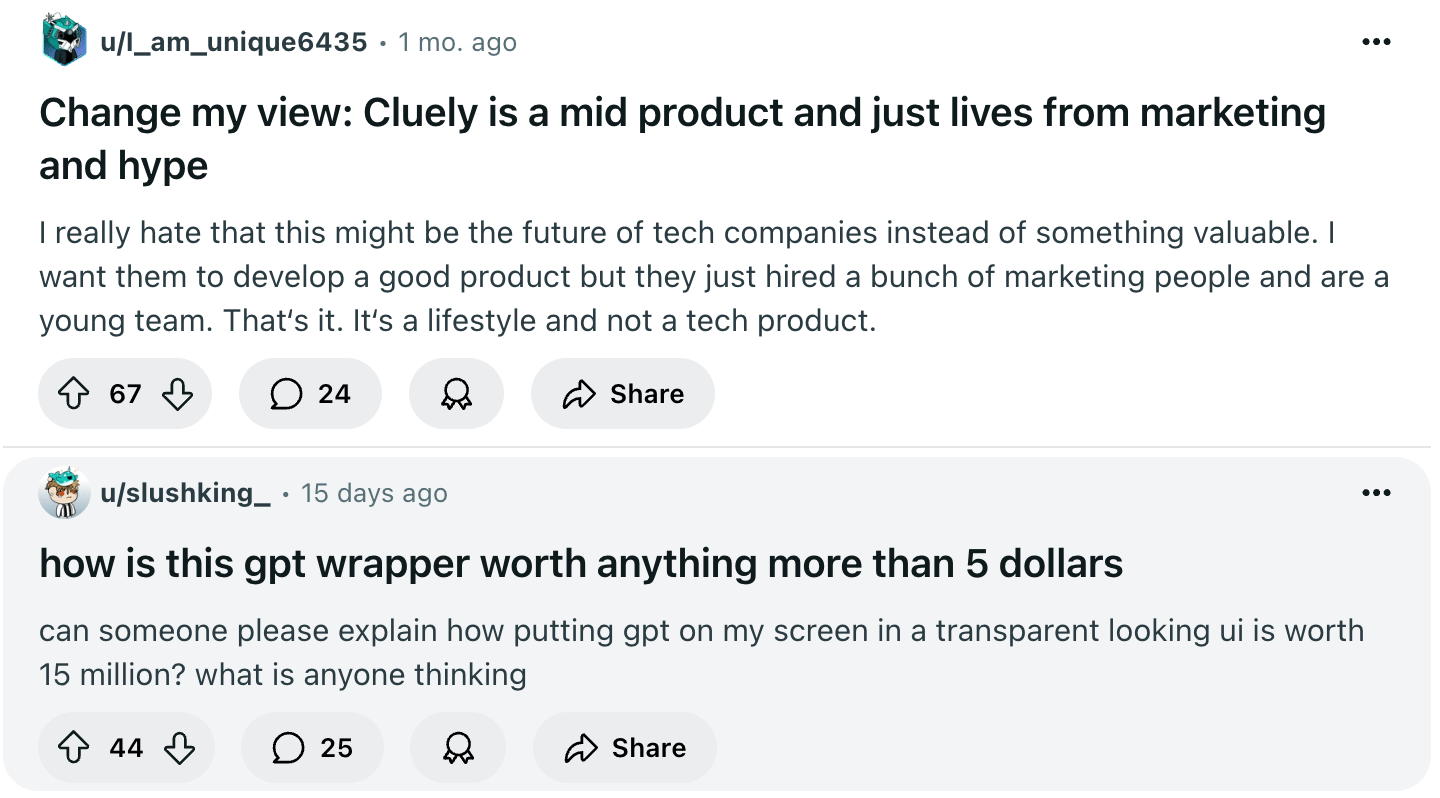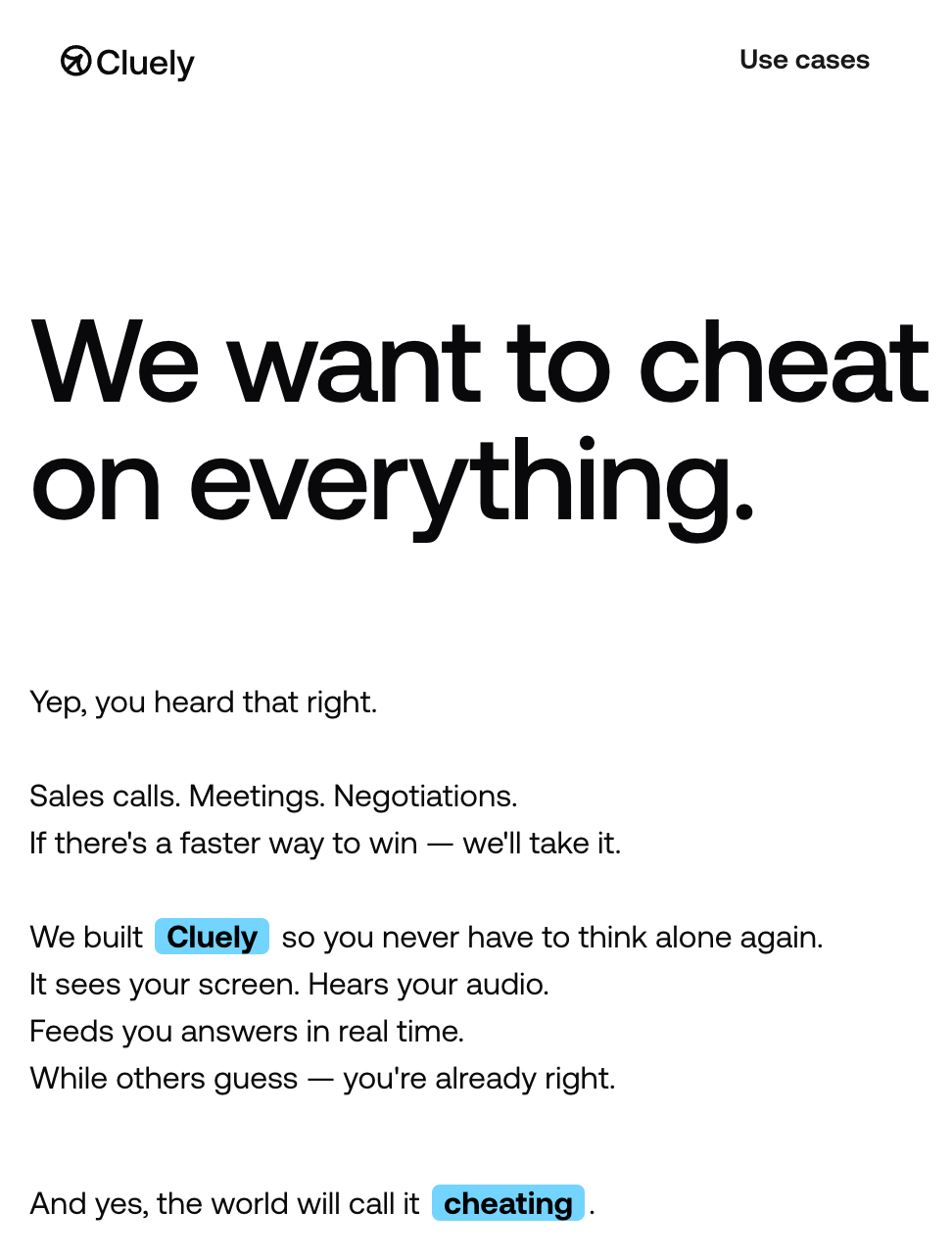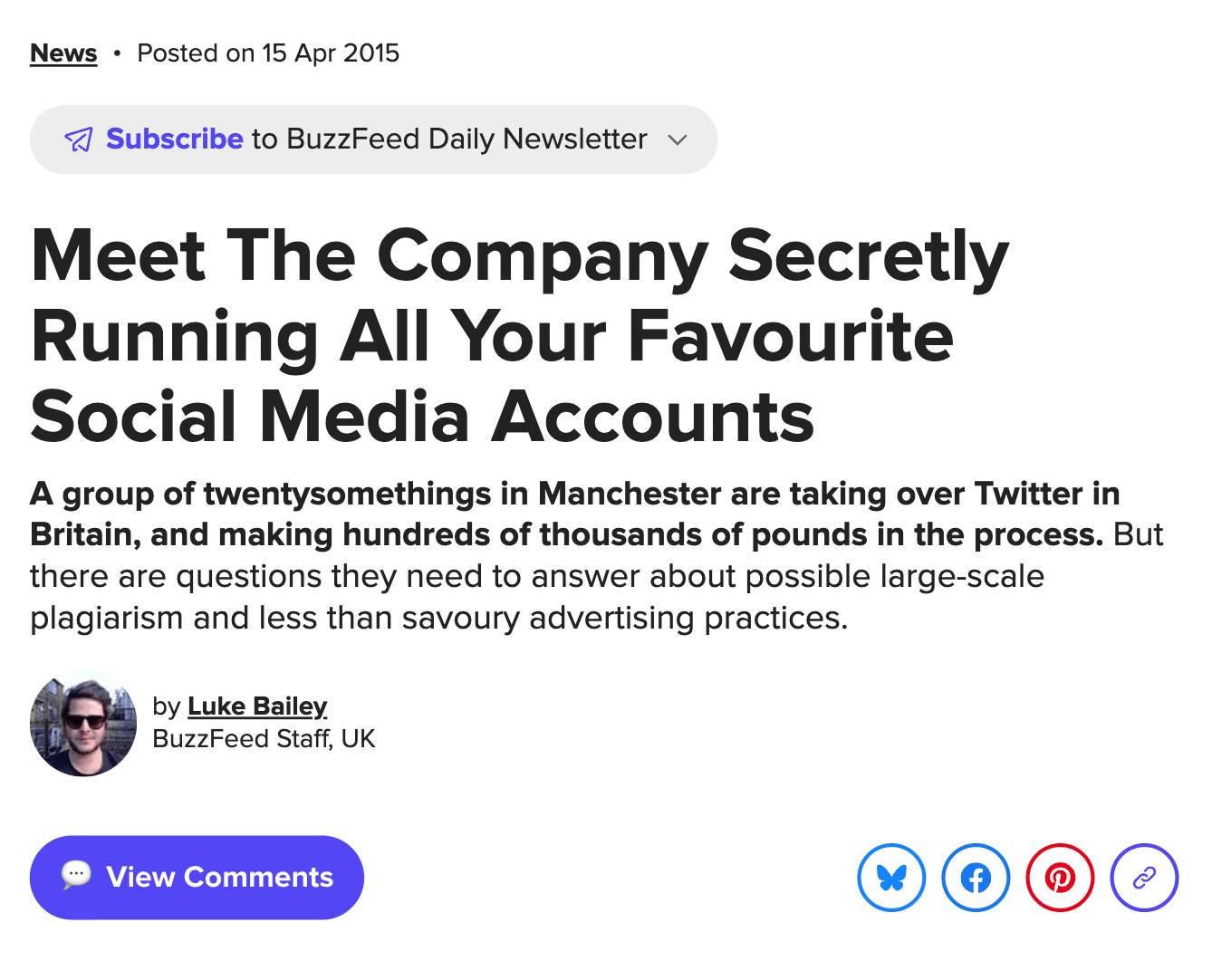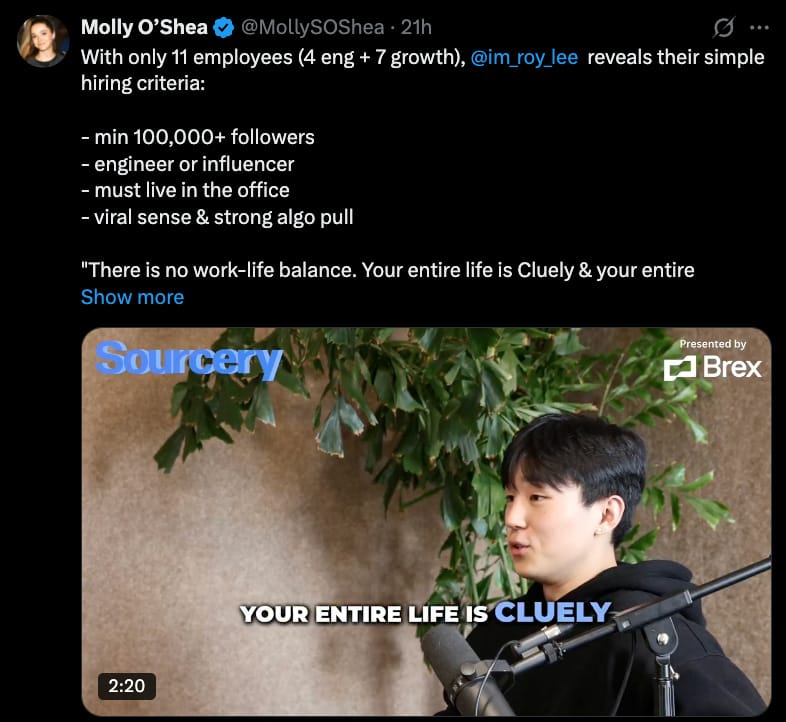- Growing Viral
- Posts
- CLUELY: THE NEW AGE OF VIRAL MARKETING
CLUELY: THE NEW AGE OF VIRAL MARKETING
The 5-Part Playbook Behind Tech’s Most Controversial AI Brand
Morning!
Have you seen all of these AI start-ups raising 100s of millions? Just this week I saw Lovable announced they were on track to raise $150M at a $2B valuation. Crazy.
(For context, Lovable didn’t even exist 2 years ago. It was launched in November 2023.)
But while it’s easy to brush these off as just the “AI Goldrush” I actually think there is a tonne of marketing lessons here. There are millions of AI companies jumping into the market, but why is it that only some rapidly rise to the top and take all of the attention?
My answer: Because of viral, cult-driving marketing strategies.
Today, I’m going to break one of my favourite examples for you.
Let’s get into it!
LISTEN TO THE AUDIO VERSION
BREAKING DOWN THE STRATEGY
2 months ago, on a miserable Wednesday night, I opened up Twitter expecting a refresh of the usual pop culture and trending nonsense which is on there.
Instead, my feed was flooded with everyone talking about this new company that helped you “Cheat on everything” and sharing this video they’d just dropped…
On the surface, it seemed like these were just a bunch of kids who’d built this new AI app. But something about it stuck with me. Over the next few months, I saw more and more about Cluely on my feed. So much so that I had to do some research and when I did… I was left in complete shock.
Started as a student project in early 2025.
Grew to $3M ARR in 3 months. Then $7M ARR 1 week later.
Raised $5.3M after just 2 months.
Then raised another $15M from A16Z.
These are numbers that are tough to comprehend.
Now, you may look at them and think… wow, this app they’ve built must be amazing. I’m yet to try it myself, but based on a few searches on social media it sounds like it’s still got a long way to go…

The reality is, Cluely didn’t get to $7M ARR in a few months because they built an astonishing product. They did it through viral marketing.
I just spent the last couple of hours searching every corner of the internet to see what they did. I narrowed it down to 5 key principles they built from.
Here are the 5 marketing principles Cluely leaned on to build a $100M+ company in 6 months ⤵️
Principle 1: Be something people can hate
What’s the best way to build a brand no one forgets? Make 80% of people hate you.
Just think of any brand with a cult following and you’ll notice there’s a large subsection of people who can’t stand them.
Apple → Rejected by the majority of tech users at first, with only a niche crowd willing to use Apple products. (You’ll still see Android users hating on them today.)
Tesla → Called overpriced, dangerous, and a personality cult. Yet the fans defend the brand relentlessly and treat new features like gospel.
Gymshark → Dismissed early on as an unserious fitness brand, built for lads who only train arms. Now they’re a multi-million pound business with global reach.
In every case, the hate became part of the growth loop. The more people argued about them, the more visible they became. And the more visible they became, the more loyal their niche audience became in return.
Cluely followed the same playbook.
They launched with one of the most provocative taglines of any start-up I’ve seen: “Cheat on everything.”

Screenshot from their manifesto
In reality, Cluely is a helpful AI assistant. It gives you live transcription, answers questions mid-call, and helps you sound smarter in meetings. But you don’t go viral by being helpful. You go viral by being divisive.
Cluely framed their product as a way to cheat, knowing full well that most people hate cheaters.
The reaction was instant. Some called it unethical. Others said it was the beginning of the end for workplace integrity. But that 20% who saw it as a cheat code? They loved it.
And Cluely built for them.
This isn’t just a bit of a controversial tagline though, across all of their marketing and messaging they lean into this divisiveness. Just take a look at this recent tweet from their CEO Roy Lee:
introducing @cluely.
today is the start of a world where you never have to think again.
we just killed 9 industries (thread):
— Roy (@im_roy_lee)
10:00 PM • Jun 27, 2025
Notice how he says, “We just killed 9 industries.”
That line wasn’t written for the industries he claimed to kill. It was written to get them talking.
To annoy the 80%, so the 20% would lean in.
When you choose to be the brand people love to hate, you stop needing to explain your product. People spread the message for you.
Principle 2: Have a polarising identity
If the message makes people angry, the brand needs to make them even more uncomfortable.
Cluely don’t just say things to get people riled up. They positioned themselves as polarising too.
From the very beginning, they proudly described themselves as a fratty start-up.
In a feature by The San Francisco Standard, the team was portrayed as a chaotic crew of dropouts living together in a three-storey house in SoMa. The piece called them “intentionally fratty” and highlighted bunk beds, garage workouts, and content shoots.
Rather than pushing back on that image, Cluely leaned in. In fact, they purposely promoted it.
That wasn’t a label the media gave them. It was the label they wanted.
They positioned themselves as young, rebellious, and slightly ridiculous - and made sure everyone saw it.
Even Roy Lee’s LinkedIn profile plays into the act. Under his education at Columbia University, it reads:

To the tech establishment, it all looked unprofessional. To their audience, it looked fun, chaotic, and relatable.
As I was learning more and more about the PR around the brand, I couldn’t help but think it mirrored what happened with Social Chain in the UK.
When that company first gained traction, BuzzFeed published a feature describing them as a “meme factory” run by kids who controlled the internet from a Manchester basement.

Cluely is doing the same thing, just slightly louder.
Principle 3: Virality over talking to users
One of the most interesting things about Cluely is there constant focus on virality. Their CEO, Roy, has made it abundantly clear in his social posts that their main focus marketing-wise is virality.
unpopular take:
virality >> talking to users
10,000 users’ worth of data is a lot more helpful than talking to 3 users
it’s just not recommended because not everyone can get 10,000 users’ worth of data immediately
except thx to short form, u can now
think more ab going viral
— Roy (@im_roy_lee)
4:01 AM • Jul 21, 2025
Rather than taking the traditional route of: sharing updates, chatting with users, trying to build a community. Instead, they engineered a system that made their content unavoidable, regardless of whether people even knew what the product did.
At the centre of it was one tactic: A clipping farm.
Roy Lee, Cluely’s CEO, recently broke down that they’ve hired over 700 “clippers”, people whose sole job is to take Cluely content, chop it up, and repost it across TikTok, YouTube Shorts, and Instagram Reels.
Here’s how it works:
Recruitment: Cluely finds clippers by scrolling TikTok and messaging anyone who posts decent short-form content. Most of them are young creators in Eastern Europe, keen for any paid opportunity.
Incentives: They don’t pay per clip. They pay per view, offering a fixed bonus for every thousand views generated. No baseline salary. No upfront cost. Just performance.
Power law economics: Around 1% of their clippers drive the vast majority of views. So they identify that one percent and invest more into them, paying them better to stay close and scale output.
This way content might flop on Cluely’s main account. But with 700 clippers cutting and reposting it, using different captions, thumbnails, and audio hooks, they massively increase the odds that some version of it will take off.
And that’s why you’ve probably seen a Cluely video, even if you’ve never followed them.
Principle 4: Make Everyone A Marketer
My favourite thing about Cluely is how they treat marketing as a company-wide function.
They’ve intentionally built a team where almost everyone contributes to visibility. Not just through a few behind-the-scenes tasks, but through actual, public content.

Just take a look at some of the follower counts in their team:
Their CMO, Daniel Min, has over 190,000 followers on LinkedIn
Ben Aratame has 180,000+ followers on TikTok.
Katie Xu has 50k on Instagram.
Other team members have 100,000 or more followers each on platforms like Twitch.
Roy Lee, their CEO, regularly pulls in millions of views per post. One fundraising tweet alone reached 5.4 million views
But these aren’t vanity stats. They’re baked into the strategy.
The team lives and works out of a house in San Francisco that doubles as a content studio. Everyone is involved. Whether it’s skits, product demos, or podcast appearances, the content flows through the team, not just a social manager.

(Even their engineers show up on camera.)
It’s not about one person being the face of the company. It’s about giving the brand as many distribution channels as possible.
This is Daniel Priestley’s KPI model taken to a new, more modern level.
Principle 5: Make it real in real life
After reading through the first 4 principles, you should have quickly got the picture that Cluely clearly have a digital-first strategy. So I wanted to include this last one to show you how impressive they are in real-life marketing activities too.
That being said, they are just as polarising in real life as they are online…
In July, they threw an unofficial afterparty for the Y Combinator AI event. It was open invite, loud, and way over capacity. Over 2,000 people showed up. The police had to shut it down.

Rather than apologise, they posted photos of the house covered in red Solo cups and promised an even bigger one next time.
Seems chaotic, but really, it just ties into everything else they are doing.
It reinforces the brand. Fast, chaotic, slightly ridiculous. It makes the myth of Cluely feel real. People don’t just hear about it online. They have been in the room, seen the madness, and told their friends.
It is also brilliant content. Every party becomes a backdrop for videos. Every stunt turns into clips. Every moment becomes something someone will tweet about.
At one point, they even teased a 1.5 million dollar rave, alongside a mock anime-style advert about helping the hero “ace life challenges”.
It sounds over the top because it is. That is the point.
Most founders would not risk their reputation on something that might get shut down by police. Cluely leans into that tension. The chaos is part of the story.
And when you are building a start-up that relies on being talked about, real-world spectacle is one of the fastest ways to make people care.
TL;DR
1/ Be something people can hate
2/ Have a polarising identity
3/ Virality over talking to users
4/ Make everyone a marketer
5/ Make it real in real life
It’s safe to say Cluely’s strategy isn’t one that every brand should take on board. But it’s safe to say it’s working for them.
If you found this interesting, please do share it with a friend!
Until next Sunday.
— Niall
WAIT… BEFORE YOU GO
Rate this week's breakdown |
BROUGHT TO YOU BY
Fact-based news without bias awaits. Make 1440 your choice today.
Overwhelmed by biased news? Cut through the clutter and get straight facts with your daily 1440 digest. From politics to sports, join millions who start their day informed.

